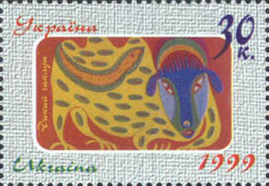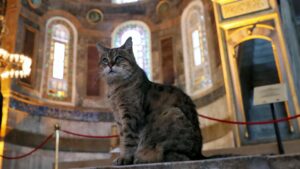by Amineddoleh & Associates LLC | Mar 1, 2022 |
During conflict, art and heritage is often the target of aggression or simply collateral damage. As discussed in our post from last Friday, art and cultural heritage in Ukraine continues to be at risk during Russia’s invasion.
Sadly, the destruction of art has been confirmed. According to a tweet from the Ministry of Foreign Affairs of Ukraine, one of the casualties from the attack on the Kyiv region was a collection of 25 paintings by notable Ukrainian artist, Maria Prymachenko. These works were stored in the Ivankiv Historical and Local History Museum which is located around 50 miles from Kyiv. While the destruction of the works has not been independently confirmed, several sources reported that the town in which the museum is located has been under fire. Further, satellite images show that the museum itself had been destroyed.

Ukrainian stamp featuring Maria Prymachenko’s art
Maria Prymachenko, who passed away in 1997 at the age of 88, was a self-taught artist best known for her colorful folk art. After seeing an exhibition of her work in Paris, Pablo Picasso stated, “I bow down before the artistic miracle of this brilliant Ukrainian.” The year 2009 was declared the Year of Maria Prymachenko by UNESCO. The Ministry of Foreign Affairs’ tweet highlighted Prymachenko for her “world-famous masterpieces” and “special gift and talent”. Her works have been honored by her home country, when they were featured on Ukrainian postage stamps. Ms. Prymachenko was also honored internationally, when UNESCO declared 2009 as the “Year of Maria Prymachenko.” Russia’s invasion has already caused significant destruction to several Ukrainian cities and one such casualty has been the museum and Prymachenko’s notable and priceless works.
Although not confirmed, social media reports that potentially looted Crimean artifacts have already appeared on the black market in the United Kingdom.
by Amineddoleh & Associates LLC | Nov 29, 2021 |

Sack of Rome by the Visigoths on August 24, 410 by JN Sylvestre (1890)
Amineddoleh & Associates LLC is pleased to once again collaborate with the American Institute for Rome Culture by contributing to the excellent series on its WEBSITE. Our most RECENT ARTICLE examines the legal tools used to fight against the destruction, looting, and illicit trafficking of cultural goods. The piece traces both national and international efforts made to protect heritage, with an emphasis on work by Italian authorities to protect its cultural goods.
by Amineddoleh & Associates LLC | Dec 10, 2020 |
The concept of “heritage,” while commonly used in reference to artwork, can also apply to living beings. This includes animals who occupy certain social and cultural functions. Today’s post explores a unique phenomenon in cultural institutions: the role of cats.

One of the Hermitage Cats (courtesy of beautifulrus.com)
Cats have been the subject of fascination – and even worship – for humans since ancient times. In Egypt, the cat-headed goddess Bastet was renowned as a protector. The Temple of Bastet, a 2,200-year-old temple in the city of Bubastis, yielded a treasure hoard in 1906, comprised of gold and silver items. Nowadays, felines can be found protecting cultural institutions in the flesh – or rather, fur. For instance, the Hermitage Museum in St. Petersburg, Russia has a population of approximately 50 cats in its basement, which has hosted feline residents since the mid-1700s. Empress Catherine the Great bestowed them with the status of guardians of the art galleries, as a gesture of gratitude for their eradication of rodents from the premises. The museum’s cats have become extremely popular with the local community, giving rise to the Day of the Hermitage Cat initiative in 1999. Over 800 photographs and prints were submitted and displayed in 2020 as part of the annual tradition. But these cats have captured hearts abroad as well. Recently, a French philanthropist left a provision for the cats in his will. The funds will likely be used to repair their basement home, ensuring that the cats will have shelter for years to come.

Gli in Hagia Sophia (courtesy of TRT Worldwide)
Other cities have also embraced cats as heritage guardians. Rome has supported its feline population by officially declaring that they form part of the city’s “bio-cultural heritage.” The law of the surrounding Lazio region states that stray cats have the right to stay wherever they are born, and are entitled to food and medical assistance. Notably, the worship of cats reached ancient Rome from Egypt; legend has it that these denizens accompanied Cleopatra on her visit to the Eternal City. Cats were particularly valued by the Romans since they helped curb rodent-borne diseases, such as the bubonic plague. Currently, the archaeological site of Torre Argentina – where Julius Caesar was famously murdered – has hosted a Cat Sanctuary since 1993. A revolving group of “cat ladies,” or gattare, from various countries provide the residents with food and care. Interested individuals can even “distance adopt” one of these historical strays. This “suburban oasis” has become a vital part of the community and attracted the patronage of actors, diplomatic families, and even a former opera singer. In the words of the Sanctuary, these “aristocratic cats rule over their temples with pride.” The Protestant Cemetery, the final resting place of Romantic poets John Keats and Percy Bysshe Shelley, has another dedicated sanctuary where cats have a peaceful place to roam. The cats provide an interactive experience for visitors while drawing in donations for the site’s upkeep, thanks to a charitable organization.

Doorkins Magnificat (photo courtesy of CNN)
Perhaps not surprisingly, religious institutions have also welcomed four-legged visitors. This past October, London’s Southwark Cathedral laid to rest Doorkins Magnificat, a former street cat who found a home in the church in 2008. As one might expect from a cat with such an illustrious name, Doorkins was well-loved by visitors, congregants, and clergy; she even met Queen Elizabeth II. As a mainstay of the community, Doorkins found fame in a range of church-sponsored merchandise – including a children’s picture book – and had her own Twitter account with thousands of followers. Doorkins’ farewell was streamed online, and it was the first service held for a cat in the illustrious history of the cathedral. The Hagia Sophia in Istanbul, Turkey also lost its internationally-acclaimed resident cat, Gli, this year. Gli was born in the museum and received much attention on social media and national news channels. She was considered a local celebrity and received a visit from former U.S. President Barack Obama in 2009, gaining over 130,000 followers on Twitter. Upon her death, the beloved cat received thousands of tributes by fans and art historians before being buried on site.
by Amineddoleh & Associates LLC | Jan 5, 2018 |

 The new year is off to a great start with another international repatriation. Later this month, fragments of a mummy will be returned to the Arab Republic of Egypt. The skull and two dismembered hands were taken from Egypt in the 1920s in violation of the nation’s antiquities laws. Leila Amineddoleh served as the cultural heritage law expert for the government.
The new year is off to a great start with another international repatriation. Later this month, fragments of a mummy will be returned to the Arab Republic of Egypt. The skull and two dismembered hands were taken from Egypt in the 1920s in violation of the nation’s antiquities laws. Leila Amineddoleh served as the cultural heritage law expert for the government.
Read about the case HERE.
by Amineddoleh & Associates LLC | Feb 26, 2016 |
As the world looks on in horror as the Islamic State, ISIL (also known as “Daesh” or “ISIS”) vandalizes and loots cultural heritage objects and sites, people around the world feel helpless and wonder as to how they can halt these criminal activities. Although stopping the vandalism may require military force and may risk the health and safety of volunteers on the ground attempting to stop this behavior, the public may have an influence on the rampant looting. Looting frequently occurs because there is a market for illicit antiquities. It is the responsibility of collectors, public institutions, and other art market players not to purchase or deal in antiquities without full provenance. Buyers must do their due diligence, and they must not purchase works from conflict zones that are not accompanied with full ownership histories and official export documentation. Leila Amineddoleh discusses this topic in a recent editorial in the Guardian.







 The new year is off to a great start with another international repatriation. Later this month, fragments of a mummy will be returned to the Arab Republic of Egypt. The skull and two dismembered hands were taken from Egypt in the 1920s in violation of the nation’s antiquities laws. Leila Amineddoleh served as the cultural heritage law expert for the government.
The new year is off to a great start with another international repatriation. Later this month, fragments of a mummy will be returned to the Arab Republic of Egypt. The skull and two dismembered hands were taken from Egypt in the 1920s in violation of the nation’s antiquities laws. Leila Amineddoleh served as the cultural heritage law expert for the government.